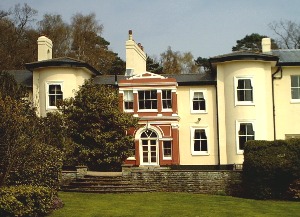![]()
Additional Information
|
A Selsdon & Sanderstead Walk Additional Information |
| london-footprints.co.uk |
|
WETTERN
TREE GARDEN The Wettern family began as ship brokers later expanding into builders merchanting. In the 1900s they moved to Sanderstead where the two elder brothers built homes. Later they purchased land in nearby Purley Oaks Road to create gardens for their favourite plants. Eric designed a series of themed gardens and built a summerhouse. He collected specimen trees on his travels and from friends. Meanwhile Herbert created a rose garden. The garden was transferred to Croydon Council in 1965/6 when the name was changed from 'Roselands'. It has many rare and unusual trees (most labelled) and a colourful delphinium border. It is open every day until dusk. |
SANDERSTEAD
The Manor of Sanderstead was granted to the Minster at Winchester
in 964. In 1539 it was leased to Sir John Gresham, who later
became a Lord Mayor. In 1600 it passed into the Atwood family who
remained until 1919. The population was around 200 from 1801-1871
doubling to 400 in the 1880s. Most people were employed in
agriculture and services for the large houses. Limpsfield Road
was the route to and from Croydon markets. The White House was a
timber-framed Tudor building which served as a farmhouse. In the
1880s the Cowdrey family were living at White House Farm and in
the 1920s its meadow became a cricket field.
|
|
Beechview Cottages 1770s |
Gresham School 1875 |
Gresham's School was built in 1875 and had two classrooms with open fires. It was expanded in the 1930s. The village shop of 1850 became a sub post office in 1890. It was Sanderstead's only shop until Cranleigh Parade was built in the 1930s. Beechview Cottages of flint and brick were built in the 1770s. On the left hand side number 79 was the former HQ of Charrington Brewers. The new Waitrose store replaces buildings of Borough Farm. Sanderstead Recreation Ground was originally fields and glebe land and served as a cricket pitch in 1895. Some estate cottages of 1869 have the Atwood crest. At 117 is the 18th century building that was once the smithy. It was last used as such in 1923 and is now the hall of the Church of the Holy Family next door. Phoenix House stands on the site of the fire station, redeveloped in 1998.
 |
HEATHFIELD This was originally the farmhouse of the early 19th century Stones Farm. The estate was purchased in 1872 by Henry Goshen who enlarged the property into Heathfield House. After 1919 the estate was owned by Howard Houlder and later Costain during which time it fell into disrepair. It was purchased by Raymond Riesco in 1927 who spent a considerable amount on the estate. Initially the farm was leased to race horse breeder Peter Thrale but later it became Riesco's model farm. The gardens were landscaped and planted including the rhododendron & azalea glades. There is also a rock garden, walled garden (formerly used as a kitchen garden) and orchard (now an ecology centre - see below). The garage block was once the stables and coach house with hay loft and flat for the stable lad. In accordance with an agreement made by Riesco the estate was purchased by Croydon Council on his death and the gardens opened to the public. The farm is now leased to a tenant. The Grade II listed house is used as a training centre. |
ECOLOGY CENTRE
This was founded in 1997 and has two old varieties orchards,
traditional hedgerows, two ponds and two lawnmowers (sheep!).
Conservation volunteers meet on the first and third Sundays when
it is also open to the public. The group can offer advice and
assistance to environmental groups and individuals and services
to schools and local groups. The warden can be contacted on 020
8651 1046 (office hours) or 020 8657 0954 (evenings).
RESOURCES
Croydon's Parks - an Illustrated History by Mrs M A Winterman
Selsdon and Croham - Living History Local Guide No 6
Woodland Ramble - LB Croydon Parks Department
London Loop - section 4
london-footprints.co.uk 2004
[Route & what to see] [walks list]